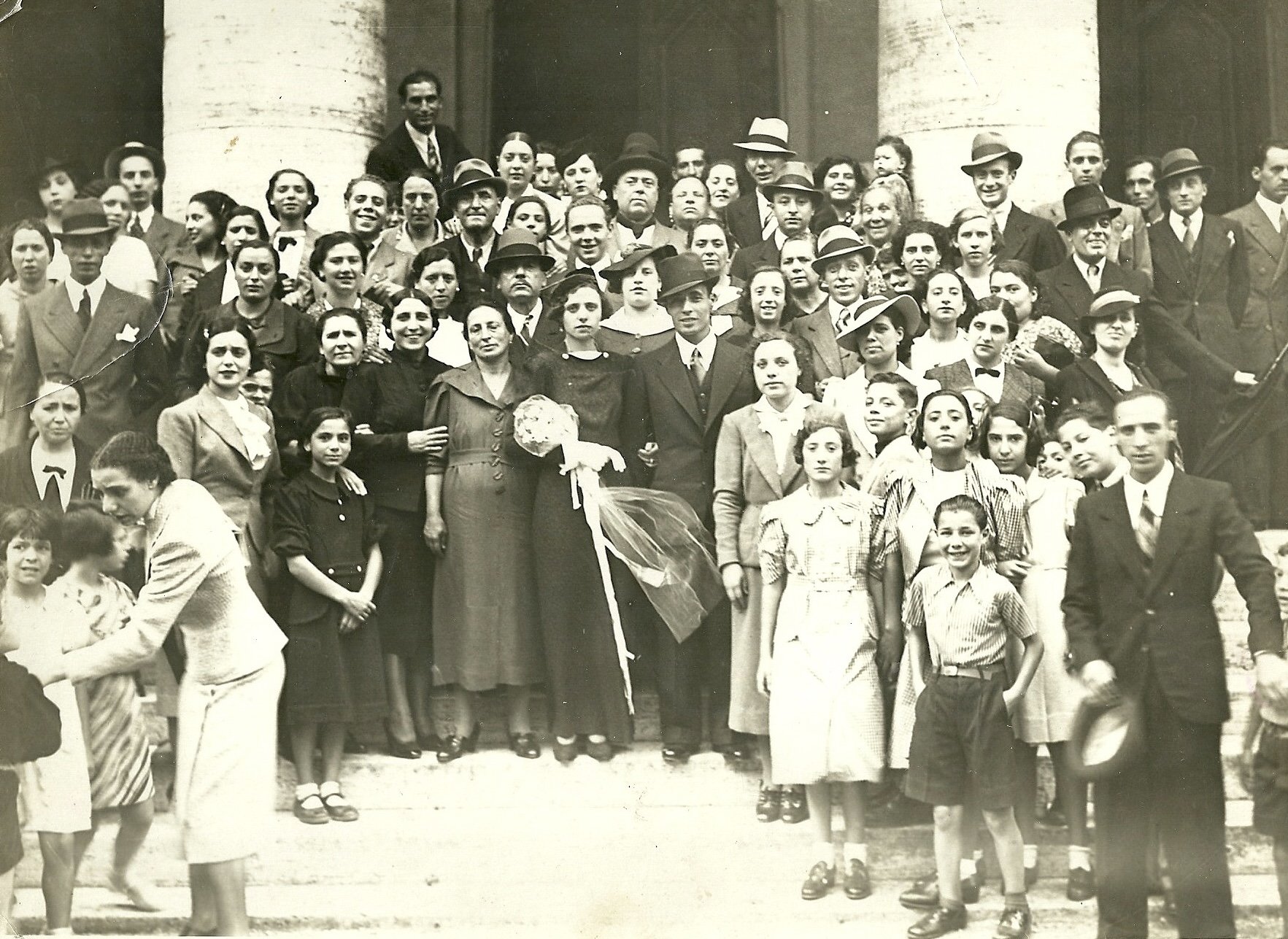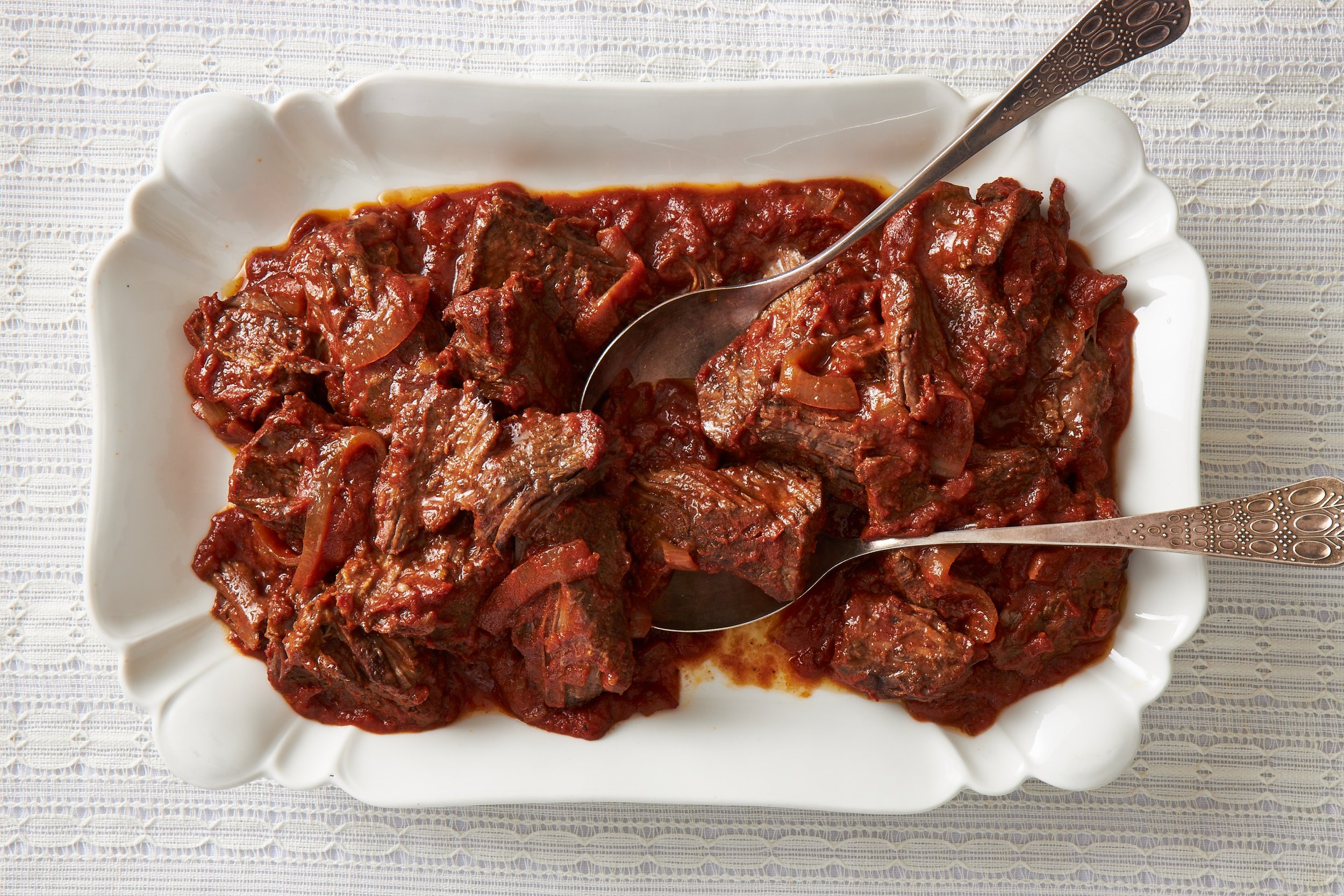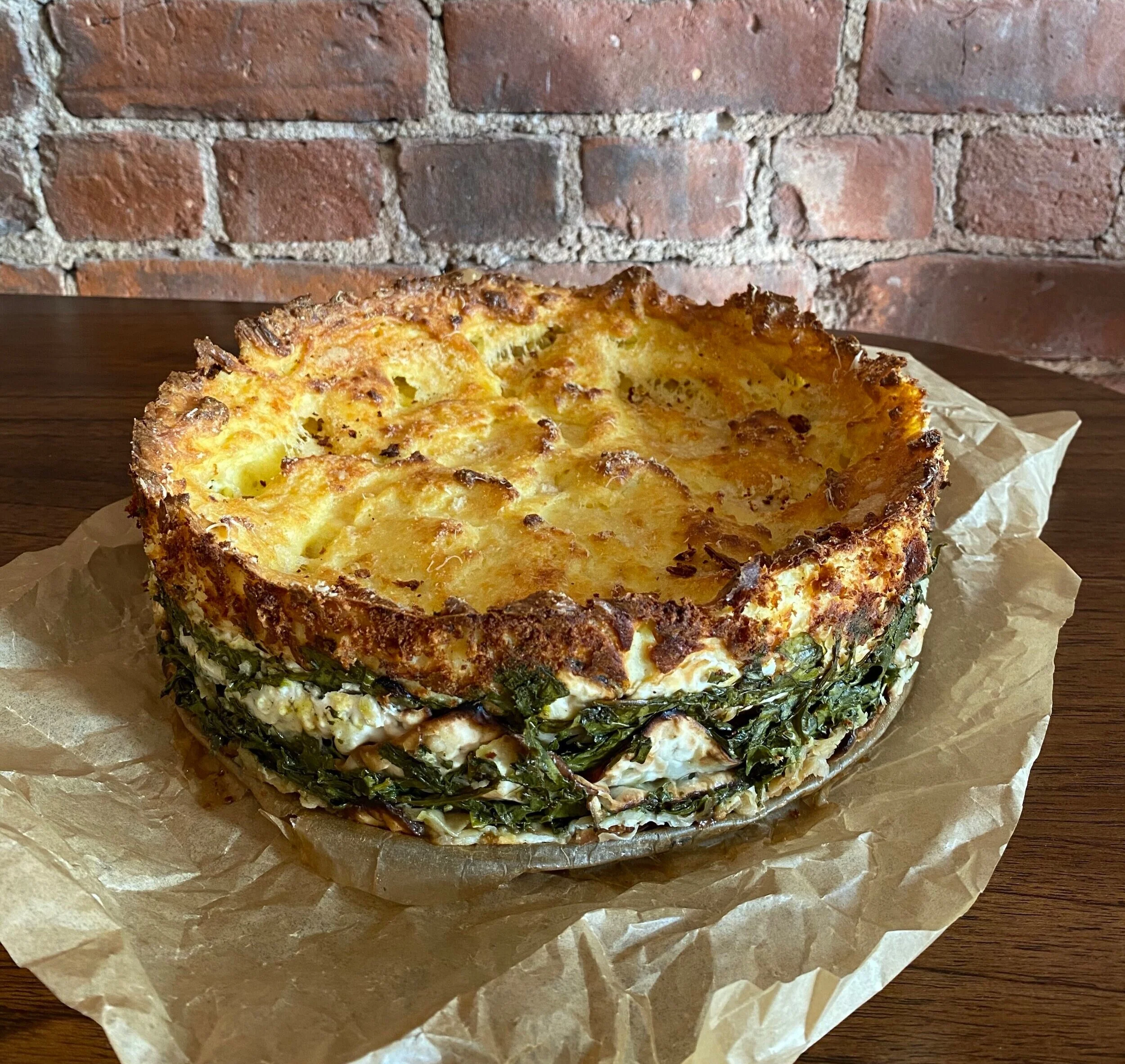A Roman Passover Menu From an Ancient Community
Photos by Penny De Los Santos, Food Styling by Judy Haubert and Prop Styling By Vanessa Vazquez.
Shared by Micaela Pavoncello
Recipe Roots: Rome, Italy
Passover dinners in Rome when Micaela Pavoncello was little were a study in contrasts. With her mother’s Libyan family who moved to Rome in 1967, the Seder took five hours. Her father’s family, who trace their roots in Rome to the time of Julius Caesar, spent just 15 minutes on the Seder. “I was always happy to go to my father’s side,” she jokes. “At the end, we would be eating good food, very good food, on both sides.”
Today, she hosts her family for Seder in the Roman neighborhood Monteverde Vecchio at an apartment she shares with her husband Angelo and their three sons. “We are 11 at best, nine generally,” she says. “All of us bring the family recipes.” Her mother-in-law makes riso al uovo or rice enriched with eggs, and roasted lamb with potatoes. There’s also stracotto or beef braised in tomato sauce and vegetables dishes like artichokes with peas and roasted endive that reflect what’s in season locally around the holiday. For dessert, there are pizzarelle or sweet matzo fritters made in her family with raisins, cocoa powder, and orange zest.
Micaela’s grandparents (center) the Great Synagogue of Rome in 1936 on their wedding day.
Roman Jews, sometimes known as Italkim, have lived in the Eternal City since the second century BCE with the community growing over the centuries as waves of Jewish immigrants arrived. Among them were Jewish slaves Roman rulers brought back with them after they conquered Jerusalem and destroyed the Temple in 70 BCE, scholar Claudia Roden explains in “The Book of Jewish Food.” The Jewish population grew again as Sephardic Jews fled Spain and southern Italy during the Inquisition. In 1555, the community was forced into a ghetto along the banks of the Tiber River where it remained for more than 300 years.
From the confinement of the ghetto came shared traditions and recipes that weave together the ingredients Roman Jews were able to procure in the ghetto, like eggplant, wild greens, and anchovies, with flavors from the Sephardic community. One of the hallmarks of Jewish cooking in Rome is how similar menus are from home to home. “Every Jewish family was doing the same dishes,” explains Micaela. Many vegetables, including the community’s iconic artichokes, are fried, meats are roasted and cooked slowly in stews. At Passover, lasagna is made with matzo and cookies called ciambellette are baked by families in a community kitchen to ensure they’re kosher and that every home can keep this tradition.
Unlike the generations before when Italian mothers spent their days at home, Micaela and her friends grew up at a time when their mothers worked and few daughters learned to cook from them. A family friend, who was the dean of the local Jewish school, stepped in, showing her how to cook. From there, “I would take from my mother’s side, from father’s side and restart recipes that were lost in the family,” she says. “By 12, I was on that career [path] of reestablishing Roman Jewish Cuisine and Libyan Jewish cuisine.”
Micaela’s grandparents in Rome in 1936.
Today, as the owner of a walking tour company called Jewish Roma, Micaela finds herself in the Roman Ghetto often, stopping at benches where elderly members of the community pass time to ask about their recipes. She’s also part of online communities where she says “I can ask anything,” about recipes and “there will be an 85-year-old woman who spends all her day cooking,” who will offer to join her on a video call to help her master a technique.
It’s not just Micaela’s generation that’s eager to preserve the community’s recipes. Young Romans in their early 20s are joining in, she says. “It’s modern, it’s a new thing and I’m really happy, because in this way we’re not going to lose the recipes.”
Roasted Lamb with Potatoes
Makes: 6-8 servings
Total Time: 1 hour and 45 minutes
Ingredients
4 ½ pounds bone-in lamb shoulder
½ cup olive oil, divided
5 teaspoons kosher salt, divided
3 ½ teaspoons ground black pepper
5 fresh rosemary branches
2 garlic cloves, unpeeled
4-6 medium red potatoes or yukon gold potatoes, peeled and cut into 1 ½ inch pieces
Preparation
1. Preheat the oven to 375 F.
2. Place the lamb onto a roasting pan. Pour ¼ cup olive oil over the lamb and rub the olive oil onto all sides of the meat to coat. Sprinkle the lamb evenly with 4 ½ teaspoons salt and 3 teaspoons black pepper.
3. Add the potatoes into the pan around the lamb. Pour ¼ cup olive oil, ½ teaspoon salt and ½ teaspoon pepper over the potatoes and toss to coat. Place the rosemary branches around the pan making sure some are making contact with the lamb and some are with the potatoes. Add the two garlic cloves to the potatoes.
4. Transfer the baking pan into the oven and roast uncovered for 1 ½ hours until the lamb is cooked through and the potatoes are golden and tender.
5. Serve hot. Micaela likes to serve the lamb whole at the table and to slice and serve at the table.
Stracotto (Beef Braised with Tomatoes)
Makes: 6-8 servings
Total time: 3 hours and 30 minutes
Ingredients
2 pounds beef chuck filet, cut into 1 ½ - 2 inch pieces
¼ cup olive oil
1 onion, peeled and thinly sliced
1 ¾ teaspoons kosher salt, divided
½ teaspoon black pepper
2 24 ½ ounce bottles tomato passata
Preparation
1. Season the beef pieces with 1 ½ teaspoon salt and 1 ½ teaspoon pepper.
2. Place a large dutch oven or heavy bottomed pot over medium heat. Add ⅓ cup of oil. Once the oil is sizzling, add as many pieces of beef that can fit in one single layer. Sear the beef until the pieces are golden-brown, about 3-5 minutes per side. Transfer on to a plate and continue searing the rest of the beef in batches.
3. Transfer the beef from the pot.
4. Add the onions into the pot and cook until they have softened and are lightly golden, 10-12 minutes.
5. Place the beef back into the pot with the onions and stir, then carefully add the tomato passata and the remaining salt and pepper into the pan. The beef should be completely covered with passata.
6. Stir the mixture and let it cook at medium for about 3 minutes, until the mixture is actively simmering.
7. Reduce the heat to low and place a lid on the pot. Cook on a gentle simmer for 3 hours until the sauce has thickened and the beef is very tender and falls apart.
8. Serve the stractotto hot with matzo.
Riso al Uovo
Makes: 6-8 servings
Total Time: 40 minutes
Ingredients
¼ cup olive oil
⅛ teaspoon red chili flakes
1 garlic clove, peeled
9 cups water
1 ½ teaspoon salt
3 cups arborio rice
⅛ teaspoon ground black pepper
2 eggs, beaten
Preparation
1. Add enough olive oil into a large pot to create a ½ inch layer of oil. Place over medium heat.
2. Add the chili and a garlic into the oil and let it cook until it is lightly browned, about 2 minutes.
3. Carefully add 9 cups of water and 1 teaspoon of salt into the pot. Bring the liquid to a boil over high heat.
4. Add the rice and bring the water back up to a boil. Reduce the heat to medium to keep cooking the mixture over a simmer. Stir the rice constantly as it cooks. After about 10-15 minutes, the rice will thicken as the water evaporates. Continue stirring the rice. Reduce the heat to medium low and keep on stirring the rice until it is creamy and the rice is tender with a bit of a bite to it, about 10-15 more minutes.
5. Transfer the pot off of the heat and add the beaten eggs, vigorously stir the mixture until the egg is evenly incorporated and emulsified into the creamy rice.
6. Serve hot.
Artichokes alla Romana
Makes: 6 servings
Total Time: Active time 15 minutes, inactive time 40-60 minutes
Ingredients
2 lemons, juiced
6 artichokes
4 tablespoons olive oil
3 teaspoons salt
1 ½ teaspoon black pepper
Preparation
1. Fill a large bowl with 4 cups of water and the juice of 2 lemons.
2. Using a serrated knife, cut off the top third of an artichoke. Trim ¼ inch off of the stem. Use your hands to peel off the rough outer leaves on the lower section of the artichoke, to expose the tender and lighter leaves. Use a peeler to peel the artichoke stem. Use a spoon or a melon baller to scoop out the spiky “choke” in the center of the artichoke heart. Place the trimmed artichoke into the lemon water. Repeat trimming the remaining artichokes and place them into the lemon water.
3. Drain the artichokes from the water and season each artichoke with ½ teaspoon salt and ⅛ teaspoon black pepper.
4. Place 4 tablespoons of olive oil into a large pot over medium heat. Once the oil is hot, place the artichokes into the pot and sear them on all sides until golden brown, about 4-6 minutes.
5. Position the artichokes upside down in the pot, so each artichoke stem is facing up. Pour enough water into the pot to cover the artichoke hearts and keep the stems above the water. Simmer over a medium to medium low heat for about 30-45 minutes, covered, until the artichokes are fork tender.
6. Serve hot.
Vignarola (Artichokes, Fava Beans, and Peas)
Makes: 6 servings
Total Time: 10 minutes active, 40 minutes inactive
Ingredients
2 tablespoons olive oil
4 fresh white cippolini onions, peeled and quartered
Juice of 1 lemon
2 small artichokes
1 cup fresh fava beans
1 cup fresh green peas
1 ½ teaspoons salt
4 leaves romaine lettuce, cut into 2-3 inch pieces
Preparation
1. Place the pol into a pot over medium-low heat. Add the onions and saute until softened, 5-7 minutes.
2. In the meantime, trim the artichokes. Using a serrated knife, cut off the top third of the artichoke. Trim ¼ inch off of the stem. Use your hands to peel off the rough outer leaves on the lower section of the artichoke, to expose the tender and lighter leaves. Use a peeler to peel the artichoke stem. Use a spoon or a melon baller to scoop out the spiky “choke” in the center of the artichoke heart. Place the trimmed artichoke into the lemon water. Repeat trimming the remaining artichoke. Cut each trimmed artichoke into 8 pieces lengthwise.
3. Add the artichokes, fava beans and peas into the pot with the onions. Season with salt and cook over low-medium heat for 2-4 minutes.
4. Place the lettuce over the vegetables in one layer. Pour ¼ cup of water over the lettuce. Put a tight-fitting lid on the pot.
5. Cook on low heat for 45-50 minutes or until the vegetables are tender.
6. Serve hot.
Torzelli (Roasted Friseé)
Makes: 6-8 servings
Total Time: 30 minutes
Ingredients
5 heads friseé
¼ cup olive oil
1 teaspoon kosher salt
¼ teaspoon black pepper
Preparation
1. Preheat the oven to 450 degrees.
2. Slice each head of friseé into quarters with the core intact.
3. Place the quartered friseé into a steam rack or colander inside your pot. Pour 2 cups of boiling water over the friseé. Put the pot over medium heat and cover with a lid. Steam the friseé until it is just tender, 4-6 minutes. Drain the friseé and pat it dry with a towel. Depending on the size of your pot you may need to steam the friseé in multiple batches.
4. Toss the steamed friseé in olive oil, salt and pepper. Place the friseé onto a baking sheet with the core side down.
5. Roast for 20 minutes, until the friseé is golden and crispy on the outside and tender on the inside.
6. Serve immediately.
Pizzarelle (Matzo, Cocoa, Raisin and Pine Nut Fritters)
Makes: 10-15 servings
Total Time: 40 minutes
Ingredients
5 unsalted matzo sheets
5 eggs
¾ cup granulated sugar
⅔ cup unsweetened cocoa powder
1 ¼ cups red raisins
1 cup pine nuts
Zest of ½ orange
⅛ teaspoon kosher salt
Vegetable oil for frying
Preparation
1. Place the matzo sheets in a large bowl and completely submerge them with room temperature water. Soak for about 20 minutes. Drain the water and use your hands to break the matzo sheets into very small pieces. Use your hands to mix and mash up the matzo almost to a thick paste-like consistency.
2. Put the mashed matzos into a large mixing bowl. Add the eggs, cocoa powder, sugar and salt and mix with a wooden spoon or with your hands to combine. Add the raisins, pine nuts and grated orange zest and continue mixing until everything is combined well and set aside.
3. Add enough vegetable oil into a medium pot to create a 2 inch layer of oil. Heat the oil over a medium-high heat until sizzling.
4. Take a teaspoon of the pizarelle mixture and use another spoon to scoop the mixture off of the tablespoon and directly into the oil, creating a quenelle or oval shaped fritter. Continue shaping and placing enough pieces of the mixture into the oil. Fry the pizarelle until they are crispy and cooked through, about 3-5 minutes. Use a slotted spoon to transfer the pizarelle from the oil and directly onto a paper towel lined plate. Continue frying the rest of the pizzarelle in batches.
5. Serve the pizzarelle warm with a drizzle of warm honey.


















